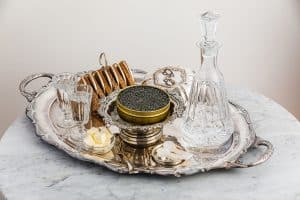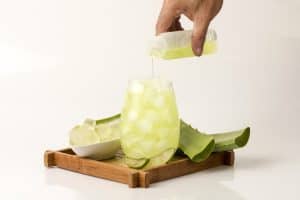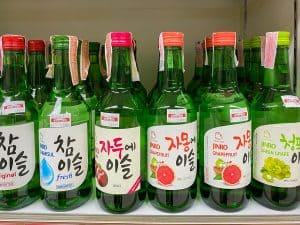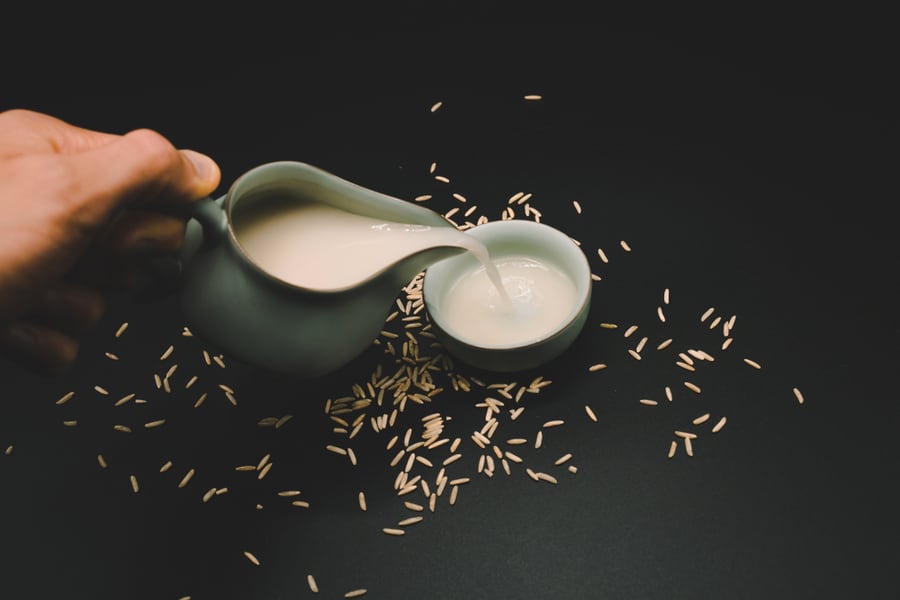
Makgeolli holds the title of Korea’s oldest alcoholic beverage, it’s been found in books as old as 2000 years old. People in Korea and all over the world are still enjoying this rice wine today, this shows how good it is. Makgeolli has also become a staple of celebratory events in Korea.
Perhaps you bought a bottle of makgeolli from the store, or you made it at home (more about how to do this later), and you want to know how to drink it like a Korean, you’ve come to the right place.
So how do you drink makgeolli?
Makgeolli is traditionally drunk from small bowls. According to Korean drinking culture, it must be drunk in one shot. You can turn the bottle over to mix it but don’t shake it.
There’s much more to drinking makgeolli than you know, let’s dive right into everything you need to know about drinking makgeolli and how to make makgeolli at home.
What Is Makgeolli & How Does It Taste?

Makgeolli is a traditional Korean alcoholic beverage. It’s made by fermenting a mixture of rice and water. It has a milky, opaque color and a thick, creamy texture. It’s usually served cold, and it’s low in alcohol content, usually around 6-8%.
Makgeolli has a slightly acidic flavor with a hint of sweetness. The flavor is almost similar to yogurt or a light beer, with a sweet aftertaste.
The aroma of makgeolli is also mild and pleasant. The aroma is usually milder than the flavor but still quite enjoyable. The flavor can vary depending on the type of makgeolli, but it is generally mild and refreshing.
How To Drink Makgeolli

Here are some makgeolli etiquettes you should know to drink this rice wine like a native.
Use a Small Bowl
If you go to a Korean restaurant and order some makgeolli, you’ll typically be served in a small bowl. Poor people in the old days drank makgeolli from bowls, so people stuck with it and it became recognized as the best way to enjoy this drink.
Drink It in One Shot
According to Korean drinking culture, makgeolli must be drunk in one shot. Makgeolli is sweet, it doesn’t taste like you’re drinking alcohol, so it’s easy to get drunk on makgeolli. Don’t take more than 4 or 5 shots, and eat food with makgeolli to slow down the rate at which you get drunk.
Be Respectful
If an older person pours you a bowl of makgeolli, you have to receive it with both hands in Korea. It’s a respectful tradition.
Don’t Shake
If you’re drinking makgeolli from a bottle, rice sediments settle at the bottom. Don’t shake the bottle like a can of spray paint, you’ll only be disrupting the equilibrium in the bottle. Gently turn the bottle upside down a few times to mix and pour it into a cup.
Some people don’t like it mixed because it’ll have a stronger alcoholic taste. These people only pour the clearer top of the makgeolli and discard the rest. Whatever works for you.
When people are served makgeolli in bowls in Korea, some use their pinky fingers to stir and then drink. You can do this when you go out for makgeolli in a Korean restaurant but be sure to wash your hands first.
How To Make Makgeolli at Home
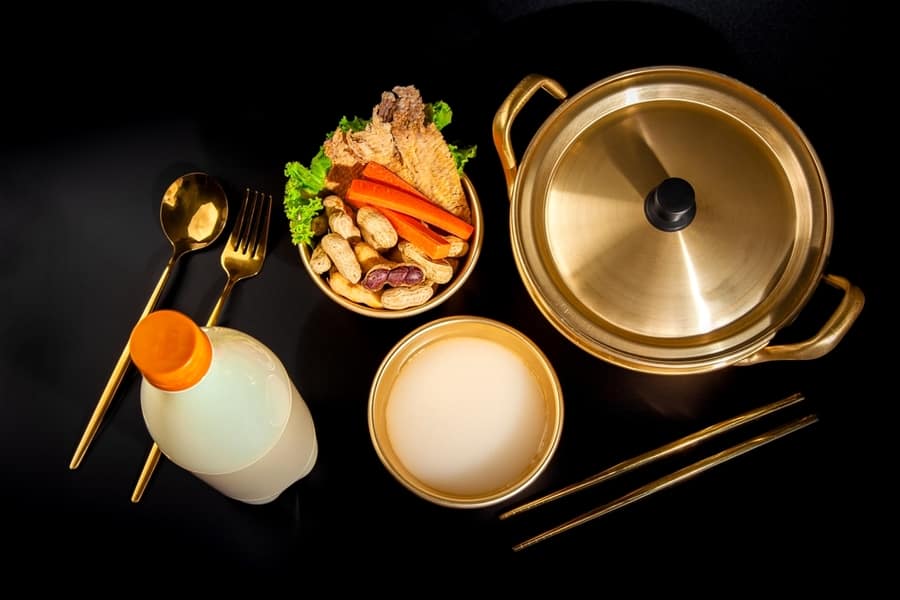
Now that you know how to drink makgeolli, if you don’t have makgeolli in stores around you and still want to experience the magic of this drink, here’s how to make it at home.
Ingredients
- Rice – 5 cups
- Starter culture (starter culture) – 1½ cup
- One packet of dry yeast
- Sugar (optional)
Instructions
- Wash your rice and pour out the milky water. You’re not done washing. Add some water to the rice again, scrub, rinse and pour out the water. You’ll have to do this until the water is almost clear.
- Add water to your rice, this is the last time, I promise. Soak it for 2 hours. Your rice should be whiter than when you first started. Pour out the water.
- Cook your rice over medium heat for 15 minutes. After 15 minutes, stir. Some people use a steamer for this process, but this works better.
- Simmer under low heat for another 15 minutes.
- Let it cool, then spread it out to dry. Using an electric dehydrator will give you better results in about 3 hours.
- By now, your rice should be crunchy. Put the crunchy rice in a glass jar. The Koreans use an Onggi for this, it has micropores to let a little air in, so it’s perfect.
- Use a wooden spoon to break your rice a little bit.
- Add your starter culture and dry yeast.
- Add 8 cups of cold water and mix.
- Next, cover the jar with a cotton cloth, you want air coming through the top. The fermentation takes 8-9 days, depending on how alcoholic you want your makgeolli to be.
- Stir the mix every morning and evening. Your first stir should be about 8 hours after you cover it. At the beginning of the fermentation, you’ll see a thick paste that’s going to get thinner as the days go by.
- On the second day, some rice grains will be gone, and you should see some bubbles.
- Around the fourth day, the mixture should be separated. The top part will be clear, while the bottom will be milky. Rice grains should be gone by now, and the mix will have a concentrated makgeolli smell.
- At the end of the fermentation, strain with a tight mesh. You’ll need to add more water to dilute it. The water you add will depend on how much makgeolli you want.
- Add sugar and stir.
- Strain the makgeolli one last time and store. Here’s a video explanation.
Storing Makgeolli
You should store makgeolli at room temperature or in the refrigerator. Once you open a bottle, it should be consumed within 2 or 3 days. Makgeolli will continue fermenting in the fridge so expect the taste to change over time.
It is best to store makgeolli in its original bottle or container, as this will help preserve its flavor and aroma. Lastly, keep makgeolli away from strong odors, as it can absorb them and change its flavor.
Pairing Food With Makgeolli
When it comes to pairing food with makgeolli, there are a few tips to keep in mind. The first is to keep the food simple: as makgeolli is a relatively light drink, it is best to opt for simple, light foods that won’t overpower the drink. Dishes such as kimchi, pancakes, and dumplings are popular choices.
It is also important to consider the sweetness of the makgeolli. If you’re drinking a sweeter variety, opt for salty or savory accompaniments as opposed to sweet dishes.
Finally, it’s important to consider the texture of the food. Dishes that are soft or easy to chew, such as dumplings, pancakes, and noodles, are all good options as they will be easy to enjoy with a cold drink. In Korean restaurants, makgeolli is often served with Haemul Pajeon (Korean-style pancakes).
A Brief History of Makgeolli
Makgeolli is said to have originated in the Goryeo Dynasty (918–1392). It was known as sindoju (신도주) or takju (탁주) during that time. Makgeolli has been enjoyed in Korea for centuries. It is believed to have been served to noblemen and kings.
Makgeolli began to decline in popularity after the introduction of Western beers and liquors in the 1960s. It was also affected by the Korean War and the Korean government’s restrictions on alcohol production.
However, it has seen a resurgence in recent years as it has become popular among young people. This revival was due to the efforts of the Korean government, which promoted the drink as a traditional cultural product.
Today, makgeolli is widely consumed in Korea and is becoming increasingly popular in other countries as well. It is often served in restaurants and bars and can be found in supermarkets and convenience stores.
The drink is also gaining a reputation as a healthy beverage due to its probiotic content and low alcohol content.
Final Thoughts
Whether you are looking for something to enjoy with a meal or just as a refreshing beverage, makgeolli is a great option. Its unique flavor, low alcohol content, and health benefits make it an ideal choice for those looking to find a new, interesting drink.
Now that you know how to drink this rice beverage, enjoy it in different ways and flavors.



